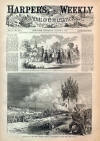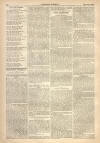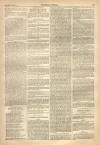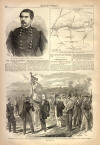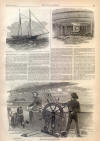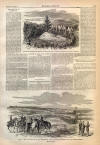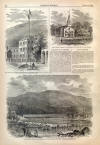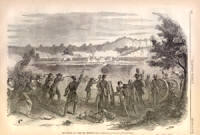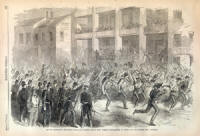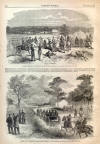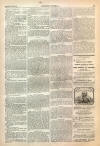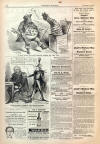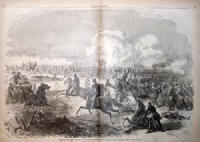The Schooner Waring
|
|
This Site:
|
AUGUST 3, 1861.] HARPER'S WEEKLY. 485 THE SCHOONER "S. J. WARING," RECAPTURED FROM THE PIRATES BY THE NEGRO WM. TILLMAN.CABIN OF THE " S. J. WARING."THE SCHOONER,"S. J. WARING."WE publish on this page an engraving of the schooner S. J. Waring, of Brook Haven, Smith, master, hence for Montevideo, July 4, with an assorted cargo. We also give views of her deck and the cabin, where the tragedy described below occurred. She returned to port on 21st, and reported as follows : On the third day out from port, the 7th inst., when 150 miles from Sandy Hook, in lat. 38°, long. 69°, was brought to by the privateer brig Jeff Davis, which sent a boat full of men alongside, and ordered the captain of the schooner to haul down the United States flag, and declared her a prize to the C. S. A. They ransacked the vessel, and took from her what they wanted—such as charts, quadrant, provisions, crockery, etc., and after returning to the schooner a second time, they put a prize-crew of five men on board without arms, and took away Captain Francis Smith, the two mates and two seamen, leaving the steward, two seamen, and Mr. Bryce Mackinnon, a passenger, on board. The prize-crew were Montague O'Neil, a Charleston pilot, in command; one named Stevens, as mate, and Malcolm Liddy, as second mate, and two men. At 3 P.M. the schooner was headed South—probably for Charleston or near by. The remaining crew and the passenger were in hopes of a recapture by some United States vessel, and made themselves agreeable and sociable to the privateersmen, and in consequence they suspected nothing until the night of the 16th of July, when fifty miles to the southward of Charleston. Seeing no prospect of their hopes being realized, and the prize captain and first mate being asleep in their berths, and the second mate at the wheel, the others dozing or asleep, the preconcerted plan was carried into effect by the steward, William Tillman (colored), killing the three with a hatchet, and throwing the bodies overboard. It was all finished in five minutes. One of the remaining men was tied up that night, and both were released in the morning on promise to help work the vessel, and were treated accordingly. After retaking the vessel the charge of her devolved on the steward. Neither he nor the rest understood navigation, but having once got hold of the land he brought her safely up to pilot ground, when Mr. Charles Warner, of the pilot-boat Jane, took charge of her. Another account gives the following details : As soon as the vessel was fairly in the hands of the secessionists, the Stars and Stripes which fluttered from the mast was taken down and cut up into pieces, in order to make a rebel flag out of it. This it was, Tillman avers, which first inspired him with a hatred and an incentive of revenge, as he saw the flag of the Union trampled upon so shamefully by those cowardly traitors to the cause of freedom. Things went on smoothly enough until the seventh day after the capture, the 14th of July—Tillman meanwhile planning in his mind the best method to adopt in order to retake the vessel. The crew of the S. J. Waring were working the vessel at the time, and consequently not kept in irons. One of the men composing the crew, named Donald M'Leod, it appears, refused taking the vessel, and notwithstanding this, the brave Tillman did not hesitate in carrying out the heroic work which he had been planning out in his mind for several days previous. Three days passed in this manner, until the night of the 16th, when shortly before the hour of midnight, Tillman determined upon freeing the vessel from the pirates. It was half past eleven o'clock precisely, according to his own statement. The captain, Montague Amiel, was asleep in his cabin, together with Stevens, the mate, in the berth next to him. The second mate, Malcom Siding, was also asleep on the poop-deck, and the other two seamen composing the pirate prize-crew, were lounging leisurely at the forehead part of the ship. Tillman stole up from between decks, with hatchet in hand, and first went down into the captain's cabin, who was sound asleep in bed. He then raised his axe and gave him a vigorous blow on his skull, from which he seemed to be launched into eternity, for he moved not an inch. The negro next proceeded to deal with the mate, who was also reclining near his captain fast asleep, and dealt with him in the same summary and terrible manner. After leaving both these men dead below, Tillman came on the poop-deck and struck the second mate a fearful blow over the temple. The unfortunate man was just rising from his reclining position, with little expectation that he was about being launched into eternity. He then went below once more, took hold of the captain's body and flung him overboard, doing the same with that of the mate and second mate. The coast being now clear, he called out to the two remaining of the crew aft, telling them that they must obey him as captain of the vessel, or he would throw them overboard also. The men yielded up without a murmur, when he had them at once ironed, but subsequently released them on their consenting to assist in bringing the vessel to a Northern port. The names of these men are James Molineau and James Dorset, one nineteen years old and the other twenty-two. The coast was now clear of danger, and the hero Tillman proceeded to use the best means in his power for the safe navigation of his vessel into a Northern port. It was at this time, finding that the S. J. Waring was too heavy for a short crew, that he offered Dorset and Molineau their liberty if they would assist him in the working of the ship. On this occasion he (Tillman) graphically expressed himself as follows: "If you cut up any didos overboard you go; recollect that I am captain of this ship now." The whole time consumed in killing the three men, putting them overboard, and getting the vessel under his own command, Tillman relates as being exactly seven and a half minutes. With regard to the scene of the tragedy the Herald reporter says: The state-room occupied by the rebel captain of the schooner presents exactly the same appearance as it did when the death-dealing strokes of Tillman hurried them into that land "from whose bourne no traveler returns." The sheets of the bed and the floor were covered with blood, and the entire scene was one at which human nature might well shudder. The berth-room of the mate did not present so revolting an appearance as that of the captain, as it appeared that he did not bleed as much as the captain. No struggle whatever appeared to have taken place in either case, but that state of disorder which resulted from the dragging of the bodies on board. The place where the second mate expired was stained with but a few spots of blood, as he lay upon the rebel flag which had been cut out from the Stars and Stripes, that bearing several marks of the crimson fluid. The flag remains at the head-quarters of the Harbor Police, together with the axe with which the deed was committed and the coat which the rebel captain was in the habit of wearing. The tonnage of the schooner is rated about 300, and she is said to be a fast-sailing and quite a stanch little craft, and belongs to Jones, Smith, & Co., of this city. There is no ordnance on the vessel. She was built in Port Jefferson, Long Island, in 1853. The negro Tillman has been confined in the House of Detention as a witness, but will doubtless shortly be liberated. He has been before the Chamber of Commerce, and it is in contemplation to present him with a substantial reward. Portrait of Tillman.THE ATTACK ON THE SECOND MATE.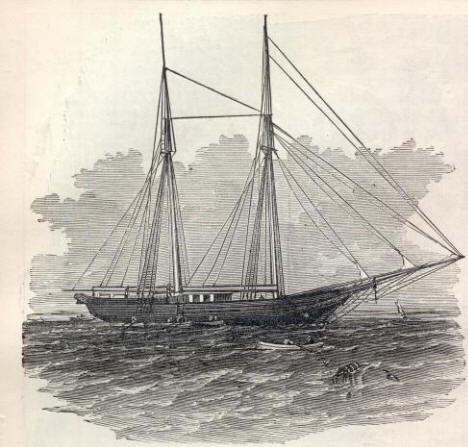 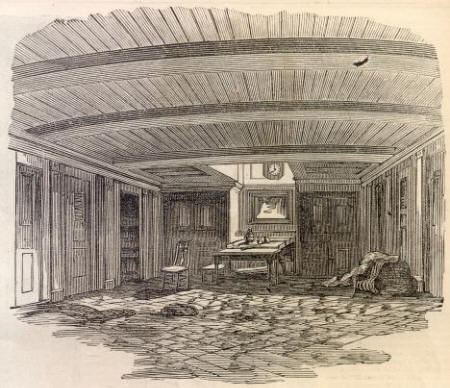 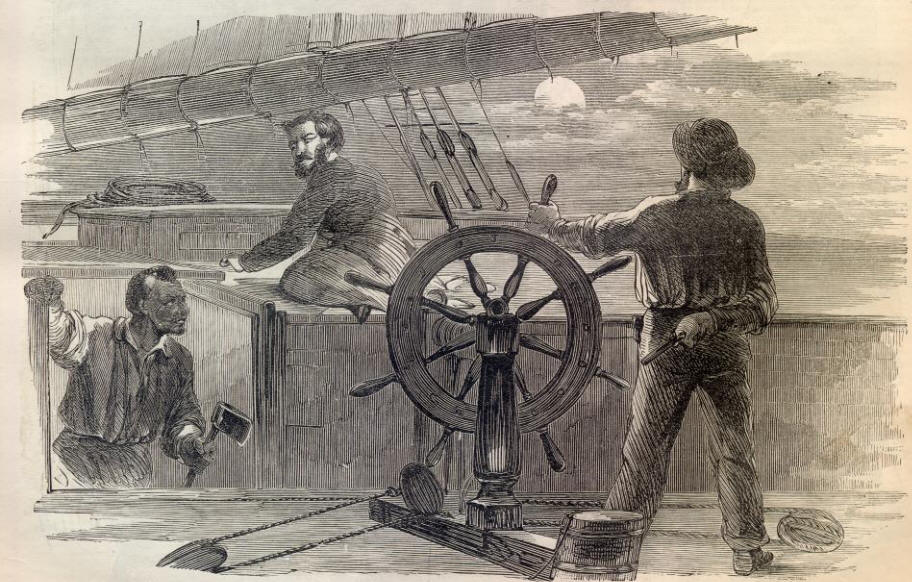 |
||||||||||||||||||||||||||||||||
|
|
||
|
|
Site Copyright 2003-2018 Son of the South. For Questions or comments about this collection, contact: paul@sonofthesouth.net |
|
|
Are you Scared and Confused? Read My Snake Story, a story of hope and encouragement, to help you face your fears. |
||
